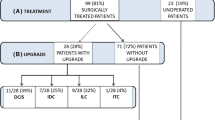Abstract
The aim of the present study was to investigate the type of intraglandular spread of lobular neoplasia (LN) and its relationship with invasive lobular carcinoma (ILC) through three-dimensional (3D) stereomicroscopy and analyses of large histological sections (histological macrosections, HM). Fifteen cases showing multiple foci of in situ LN and/or ILC (1 pure LN, 12 LN+ILC, and 2 pure ILC) constituted the basis of the present study. Thirteen cases were treated with mastectomy (including the case of pure LN), and two cases were treated with quadrantectomy. In all cases, large parallel 5-mm-thick sections were embedded in paraffin and stained with hematoxylin and eosin (H&E). Selected large paraffin blocks were investigated with stereomicroscopy. The H&E-stained HM were then compared with the corresponding tissues examined using stereomicroscopy. (1) LN was multicentric in nine cases. (2) The average maximum distance among LN foci was 37.9 mm, while the average maximum distance among ILC areas was 58.2 mm. (3) On 3D examination, LN-filled acini and ducts appeared dilated. When “Pagetoid spread” was present, the ducts were lined by a continuous layer of neoplastic epithelium. (4) No anastomoses between lobes were observed in the two cases where glandular trees were visualized. (5) In 12 cases, ILC areas enveloped ducts and acini affected by LN—an association that was more than coincidental. (6) Multicentric ILC areas not associated with LN indicated vascular spread. It is concluded that the information given in LN and ILC, obtained by analyses of large histological sections, is far superior than that obtained by analyses of conventional histological sections, which underestimate multiple distant small foci of invasion. 3D sections are useful in understanding the architecture of specific lesions.






Similar content being viewed by others
References
Dalton AJ (1949) Histogenesis of the mammary gland of the mouse. In: Moulton FR (ed) A symposium on mammary tumors in mice. American Association for the Advancement of Science, Washington, pp 39–46
Damiani S, Peterse JL, Eusebi V (2002) Malignant neoplasms infiltrating “pseudoangiomatous” stromal hyperplasia of the breast: an unrecognized pathway of tumor spread. Histopathology 41:208–215
Ellis IO, Humphreys S, Michell M, Pinder SE, Wells CA, Zakhour HD (2004) Guidelines for breast needle core biopsy handling and reporting in breast screening assessment. J Clin Pathol 57:897–902
Elsheikh TM, Silverman JF (2005) Follow-up surgical excision is indicated when breast core needle biopsies show atypical lobular hyperplasia or lobular carcinoma in situ. A correlative study of 33 patients with review of the literature. Am J Surg Pathol 29:534–543
Eusebi V, Magalhaes F, Azzopardi JG (1992) Pleomorphic lobular carcinoma of the breast: an aggressive tumor showing apocrine differentiation. Hum Pathol 23:655–662
Faverly DRG, Holland R, Burgers L (1992) An original stereomicroscopic analysis of the mammary glandular tree. Virchows Arch 421:115–119
Faverly DRG, Burgers L, Bult P, Holland R (1994) Three dimensional imaging of mammary ductal carcinoma in situ: clinical implications. Semin Diagn Pathol 11(3):193–198
Foote FW, Stewart FW (1941) Lobular carcinoma in situ. Am J Pathol 17:491–500
Foschini MP, Tot T, Eusebi V (2002) Large-section (macrosection) histologic slides. In: Silverstein MJ (ed) Ductal carcinoma in situ of the breast. Lippincott, Philadelphia, pp 249–524
Going JJ, Moffat DF (2004) Escaping from flatland: clinical and biological aspects of human mammary duct anatomy in three dimensions. J Pathol 203:538–544
Holland R, Faverly DRG (2002) The local distribution of ductal carcinoma in situ of the breast: whole-organ studies. In: Silverstein MJ (ed) Ductal carcinoma in situ of the breast, chap 19. Lippincott, Philadelphia, pp 240–248
Jackson PA, Merchant W, McCormick CJ, Cook MG (1994) A comparison of large block macrosectioning and conventional techniques in breast pathology. Virchows Arch 425:243–248
Ohtake T, Kimijima I, Fukushima T et al (2001) Computer-assisted complete three-dimensional reconstruction of the mammary ductal/lobular systems. Cancer 91:2263–2272
Page DL, Schuyler PA, Dupont WD, Jensen RA, Plummer WD Jr, Simpson JF (2003) Atypical lobular hyperplasia as a unilateral predictor of breast cancer risk: a retrospective cohort study. Lancet 361:125–129
Rosen PP, Kosloff C, Lieberman PH, Adair F, Braun DW (1978) Lobular carcinoma in situ of the breast. Am J Surg Pathol 2:225–252
Schnitt SJ, Morrow M (1999) Lobular carcinoma in situ: current concepts and controversies. Semin Diagn Pathol 16(3):209–223
Tot T (2003) The diffuse type of invasive lobular carcinoma of the breast: morphology and prognosis. Virchows Arch 443:718–724
Tot T (2005) DCIS, cytokeratins, and the theory of the sick lobe. Virchows Arch 447:1–8
Tot T, Tabar L, Dean PB (2000) The pressing need for better histologic–mammographic correlation of the many variations in normal breast anatomy. Virchows Arch 437:338–344
Weidner N, Semple JP (1992) Pleomorphic variant of invasive lobular carcinoma of the breast. Hum Pathol 23:1167–1171
Wellings SR, Jensen HM (1973) On the origin and progression of ductal carcinoma in the human breast. J Natl Cancer Inst 50:1111–1118
WHO (2203). Tumours of the breast and female genital organs. In: Tavassoli FA, Devilee P (Kleihues P, Sobin L) (eds). WHO classification of tumours, 3rd (5th) edn. IARC Press, Lyon
Acknowledgement
The experiments complied with the laws of the state (Italy) in which they were performed.
Author information
Authors and Affiliations
Corresponding author
Additional information
This work was financed by grants from the Universisty of Bologna (ex 60%; M.P. Foschini and V. Eusebi) and by grant 2002064975 (Cofin 2002) from the Ministry of University and Research, Rome.
Rights and permissions
About this article
Cite this article
Foschini, M.P., Righi, A., Cucchi, M.C. et al. The impact of large sections and 3D technique on the study of lobular in situ and invasive carcinoma of the breast. Virchows Arch 448, 256–261 (2006). https://doi.org/10.1007/s00428-005-0116-y
Received:
Accepted:
Published:
Issue Date:
DOI: https://doi.org/10.1007/s00428-005-0116-y




